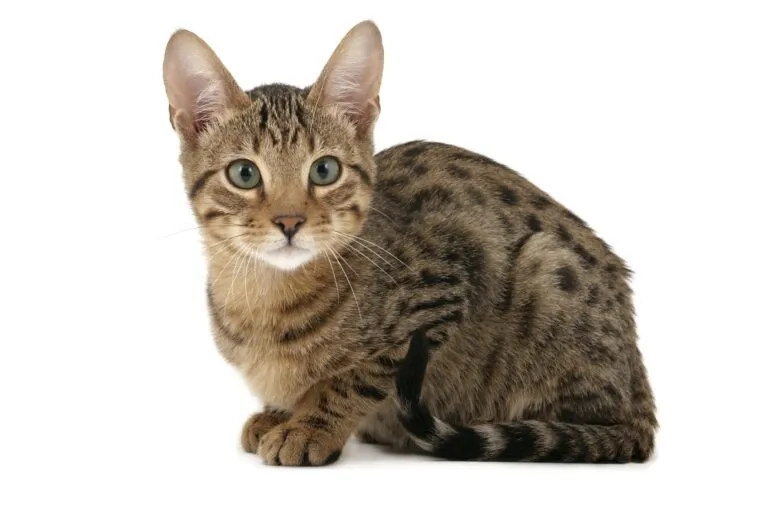Maine Coon
The Maine Coon has now become one of the most popular cat breeds in the world and is enjoying increasing popularity in Ireland, too. This is probably thanks to its authenticity, robustness and excellent character.
The Serengeti cat is a cross between the Bengal and Oriental Shorthair cat. Large ears and long legs are typical of this still young cat breed. Its spotted fur is reminiscent of the markings of an exotic predatory cat. Serengeti cats are very temperamental and should only be in the hands of experienced owners.

© Krissi Lundgren / stock.adobe.com
Large ears are typical of the Serengeti cat.
The Serengeti cat breed emerged by pairing the Bengal and Oriental Shorthair (OSH) cats.
As a cross between a domestic cat and an Asian leopard cat, the Bengal is classed as a hybrid cat. Because the Serengeti is descended from the Bengal, it also has a small proportion of wild cat – which can clearly be seen.
The Serengeti cat doesn’t just have the temperament of its wild ancestors, but has also inherited its coat pattern with striking spots.
Cat breeder organisations recognise the following Serengeti fur colours:
The spots in the short silky coat should always be clearly visible and widely spaced.
The Serengeti has a square-shaped physique. With its upright posture and long legs, it is a graceful sight to behold.
At the same time, it is strong and muscular because Serengeti breeders highly value them being in excellent physical condition.
The Serengeti is a medium-sized cat breed. Females weigh between 3.5 and 5.5 kilograms, whilst males are slightly larger and weigh 6 to 7 kilograms.
Along with the spots, the large ears are the Serengeti’s most striking feature. They are inherited from Oriental Shorthair cats and are as long as the entire head.
In addition, they have round, bright eyes as well as a long neck that merges into the base of the skull without tapering.
Cats of this breed are described as self-confident, open and friendly. When a Serengeti enters a new home, it may be a little shy for the first one or two days.
Once the initial shyness has been overcome, there’s no holding back. The Serengeti then wants to be everywhere and to help with all household tasks.
Some Serengeti cats follow their owner’s every move so they don’t miss a trick. So don’t be surprised if your Serengeti even wants to follow you to the toilet.
Like their ancestors, Oriental Shorthair cats, Serengeti cats are also very talkative and miaow a lot.
Unlike a first to fourth generation Bengal cat, there are no regulatory requirements for keeping Serengeti cats, since the proportion of wild cat blood is very low.
Nevertheless, Serengeti cats are only suitable for experienced cat owners due to their temperament.
Cats of this breed are very active and need plenty of exercise. A garden where they can let off steam is ideal. As indoor cats, they should have access to a secured balcony to get some fresh air now and then.
Like the Bengal, the Serengeti also likes water and enjoys having a garden pond or sturdy paddling pool that can withstand its sharp claws.
Your home too should offer your cat plenty of opportunities for climbing and frolics. Cats love climbing up high and enjoying the views from above. Vary the environment now and then to create new impulses.
Find a large range of tall scratching trees for your Serengeti in the zooplus online store.
Serengeti cats are said to be on good terms with other animal species. The requirement for this is you making an effort to integrate them and cautiously getting them used to one another.
The breed is considered fond of children, although not all children can cope with their boisterous temperament.
Due to its short hair, the Serengeti’s fur is relatively low-maintenance. Regular brushing isn’t necessary with this cat breed, although it may enjoy the attention that goes with grooming.
Serengeti cats are said to be in robust health. There seems to be a certain risk of bladder stones. Apart from this, there are no breed-specific diseases.
Nevertheless, even a Serengeti isn’t immune from normal cat diseases and parasites. Ensure it has the required vaccinations and take your cat to the vet once a year for a health check.
Would you like to buy a Serengeti cat? That could be difficult, because this young cat breed is still rare.
In the US, a Serengeti cat costs between 600 and 2,000 US dollars (around 500 to 1,700 euros). Among other things, the price depends on the breeder and the age of the cat.
Cats from rare breeds are also offered for sale online on numerous ad portals. However, such offers are not always reputable. Animal welfarists criticise that sellers often produce their cats in dubious conditions that are anything but species-appropriate.
Contrary to what the name Serengeti implies, this cat breed doesn’t originate from East Africa but the US, where it was created in 1994 by a breeder called Karen Sausman in California. The objective was to breed a cat resembling a Serval, an African wildcat.
As a result, it is a relatively young cat breed. The Serengeti is now listed a as a ‘provisional new breed’ with the US cat-breeder organisation TICA, but it can be registered in the stud book and exhibited.
The Serengeti impresses with its elegant, wild cat-like appearance and loving character, although this exotic cat breed is still quite rare.
The Maine Coon has now become one of the most popular cat breeds in the world and is enjoying increasing popularity in Ireland, too. This is probably thanks to its authenticity, robustness and excellent character.
Neva Masquerade – a mysterious name for a mysterious thing of beauty! The Neva Masquerade is the point variation on the Siberian cat and shares many characteristics with this breed.